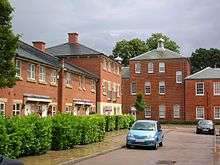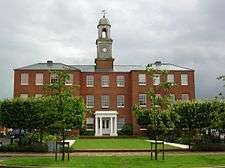Knowle Hospital
| Knowle Hospital | |
|---|---|
|
Former main asylum building, now apartments | |
| Geography | |
| Location | Knowle, Hampshire, England, United Kingdom |
| Coordinates | 50°52′54″N 1°12′15″W / 50.881570°N 1.204048°WCoordinates: 50°52′54″N 1°12′15″W / 50.881570°N 1.204048°W |
| Organisation | |
| Care system | NHS |
| Hospital type | Specialist |
| Affiliated university | University of Southampton |
| Services | |
| Emergency department | No Accident & Emergency |
| Helipad | No |
| Speciality | Psychiatric |
| History | |
| Founded | 1852 |
| Closed | 1996 |
| Links | |
| Lists | Hospitals in England |
The Hampshire County Lunatic Asylum, later Knowle Mental Hospital and Knowle Hospital, was a psychiatric hospital in the village of Knowle near the town of Fareham in Hampshire, southern England, opened in 1852 and closed in 1996.
Foundation
In 1845, the Lunacy Act and the County Asylums Act required that every United Kingdom county should build an asylum, or should join with another neighbouring county to achieve the same goal.
For the Hampshire asylum, a committee of nine JPs were appointed at the Easter Quarter Sessions in 1846 to superintend the erecting or providing of a lunatic asylum. They selected Knowle Farm as the most suitable available site, comprising 108 acres (0.43706 km2).[1]
The selection of the site at Knowle in 1849 came after the rejection of a site at Catisfield and construction of a 400 bed asylum, began in 1850. What became known as the Hampshire County Lunatic Asylum opened in December 1852. [2]
Opening
The Hampshire County Lunatic Asylum was built to the designs of James Harris, architect, and some of the construction of the hospital was undertaken by Russian prisoners from the Crimean War. The first medical superintendent was Dr Ferguson and the partially completed asylum received twenty patients in December 1852, admitted from the workhouse in Fareham. Six other patients were admitted from Grove Place, a private asylum in the nearby village of Nursling.
In 1875, a chapel was built on this site[3] to free up space in the main building.[4]
History
By 1856, the asylum had expanded to take 400 patients, and growth continued throughout the century - with over 1,000 patients in the asylum by 1900. Both male and female patients were admitted, and were expected to work on the farm, in the kitchens and in other trades to help support their community.
For about a year, in 1857/58, one of the gardeners at Knowle, Henry Coe, engaged in a personal correspondence with Charles Darwin concerning horticultural matters, especially about the cultivation of kidney beans. As a result of this correspondence, Darwin became involved in a minor dispute about the legality of a patient's detention at Knowle. Following his recovery and discharge, the patient wrote to Darwin, thanking him for taking a personal interest.
In 1879, the Portsmouth Borough Asylum (St James' Hospital) was opened in Southsea, and Knowle provided care for the rest of Hampshire; from 1917, Park Prewett Hospital in Basingstoke took over responsibilities for the northern half of the county. The staff at Knowle also developed working relationships with the Royal Hospital Haslar and Netley Hospital, both important Ministry of Defence hospitals.
The asylum was renamed Knowle Mental Hospital in 1923 and then became Knowle Hospital in 1948.
In the 1950s, Knowle housed almost 2000 patients.
During the 1970s, plans were drawn up to close the large county mental asylums and in 1979 mental health services for Southampton and south west Hampshire departed to a newly established Department of Psychiatry at Royal South Hants Hospital in Southampton.[5]
Following this transfer, Knowle became the provider of mental health services to the linked boroughs of Fareham and Gosport as well as the southern parishes of Winchester. The Knowle site also housed the Wessex regional services for child and adolescent psychiatry and the forensic psychiatry services under the leadership of Dr Malcolm Faulk.
Part of the hospital site was home to the Hampshire Ambulance Service Knowle Training School.[6]
When Knowle closed in 1996, local services devolved to Gosport War Memorial Hospital and to Hewat House (in Gosport) as well as to the Meadows in-patient unit and the Osborn Centre in Fareham. Regional forensic services remained on the Knowle site, at Ravenswood House. Nowadays the Knowle site is entirely a residential development, called Knowle Village.
Patients
By 1856, the asylum had expanded to take 400 patients, and growth continued throughout the century - with over 1,000 patients at the asylum by 1900. In the 1950s, Knowle housed almost 2000 patients. Both male and female patients were admitted, and were expected to work on the farm, in the kitchens and in other trades to help support their community.
Over 5,500 former patients of the asylum are buried in Knowle Cemetery. Before 1886 the burial locations were not recorded. Up to four patients could be buried in the same plot, although never on the same day. The last burial at the site took place in 1971. A few remaining iron crosses, used to mark the graves, were removed from the site in 2001 for secure storage, pending a decision to relocate them.
Staff
The first medical superintendent was Dr Ferguson. In the later Victorian period, the staff were led by Dr John Manley, medical Superintendent for over thirty years. His assistant was Dr Pater, the brother of Walter Pater, an eminent Victorian man of letters and Oscar Wilde's tutor at Oxford.
In the 1960s, Knowle became the setting for Dr Ronald A. Sandison's psychotherapy practice. Sandison moved to Knowle from Powick Hospital in 1964, and remained at Knowle till 1975. Sandison (1916–2010) was the influential founder of the Wessex Psychotherapy Society and he was one of many British psychiatrists intrigued by the possibilities of psychotherapeutic approaches to mental illness. In later life, Sandison played a considerable part in the affairs of the Institute of Group Analysis in London. In 1965, Knowle became the hub of the Wessex Post-Graduate School of Psychiatry, headed by Drs Ian Skottowe, Angus Galbraith and Stephen MacKeith. With the establishment of the medical school at Southampton University in 1971, the university department of psychiatry was set up at Knowle Hospital, and was led by Professor James Gibbons, Richard de Alarcon and Brian Barraclough. Barraclough's research on suicide gave an international reputation to Southampton psychiatry.
Genealogy
All documents and records of the asylum that still exist are held by the Hampshire Records Office in Winchester. The accession number for the collection is 48M94/ and many records relating to former patients are held, including admissions information, case notes, discharge and death registers, postmortem reports and a burial register. A number of these records are contained in volumes that are still subject to a 100-year closure rule; any work on those volumes, for records outside the closure period, must be undertaken by an archivist at the records office on behalf of the public.
Facilities
Knowle had a number of features unusual for a county asylum - a large chapel constructed out of the local (Fareham red) bricks (used more famously for the Royal Albert Hall in London) and its own pub, the "County Arms".
Knowle Halt, a small railway station on the Eastleigh to Fareham line, served the asylum from 1907. The station (which also served the village of Funtley) was closed in 1964. Trains from the Meon Valley Railway, a cross-country railway in Hampshire, also served Knowle Halt.[7]
Current use

From 2000 onwards, the site was redeveloped as an expansion of the village of Knowle. The development, known as 'Knowle Village' consists of apartments (using the former hospital buildings) and new houses over 53 acres (210,000 m2) of the hospital grounds.
See also
References
- ↑ "94048 - Knowle Hospital, Fareham (Alt Ref No 48M94), Hampshire County Record Office". Retrieved 2016-07-30.
- ↑ "Burt, Susan Margaret (2003). "Fit Objects for an Asylum" The Hampshire County Lunatic Asylum and its Patients, 1852-1899, University of Southampton, Faculty of Social Sciences Department of Sociology and Social Policy, PhD Thesis" (PDF). Retrieved 2016-07-30.
- ↑ "Knowle Hospital Chapel - List Entry Summary, Historic England". Retrieved 2016-07-30.
- ↑ "Knowle - History, County Asylums". Retrieved 2016-07-30.
- ↑ "KA brief history of the RSH" (PDF). Retrieved 2016-07-30.
- ↑ "Gallery - Knowle Training School". Retrieved 2016-07-30.
- ↑ "Subterranea Britannica Disused Stations Site Record". Retrieved 2007-07-27.
Further reading
- Burt, Susan (2004), Fit Objects for an Asylum: the Hampshire County Lunatic Asylum and its patients, 1852-1899 (Ph.D. thesis). Southampton: University of Southampton. OCLC 59193333
External links
- National Archives: Knowle Hospital Records
- Fareham Borough Council - Knowle Village information
- Wickham Parish Council page on Knowle Village
- Wickham Parish Council page on Knowle Cemetery
- Photographs from Knowle Cemetery
- Hampshire Records Office, Winchester
- Above All a Patient Should Never be Terrified; An Examination of Mental Health Care and Treatment in Hampshire 1845-1914. PhD Thesis by Diane Teresa Carpenter; University of Portsmouth 2010
